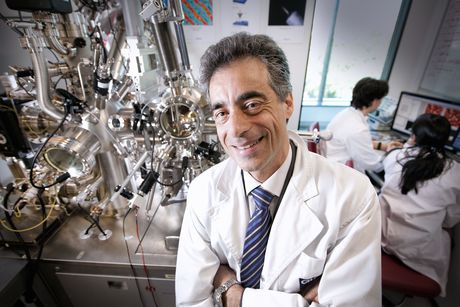New funds to recharge battery research

Professor Nunzio Motta, from QUT’s Science and Engineering Faculty, and Professor Yuegang Zhang, a leading expert in the field of lithium batteries and energy storage materials from China’s Suzhou Institute of Nano-Tech and Nano-Bionics, have joined forces to try to develop superior electric car batteries that overcome the current drawbacks of long recharge times and short running distances. The project is being funded by a $250,000 grant from the Queensland-Chinese Academy of Sciences Collaborative Research Fund.
Professor Motta said the aim of the project was to find a scalable technology to produce low-cost supercapacitors, an alternative to traditional lithium batteries, with the highest possible performance.
“Today commercial supercapacitors based on activated carbon can store up to one twentieth of the energy of Li-ion batteries with similar weight and size, but they can be recharged in minutes and can release a large amount of power,” said Motta.
“To make them competitive and exploit their superior power output in real-world applications like electric cars, mobile phones or computers, it is crucial to increase their energy storage capacity.
“We are developing a graphene supercapacitor, which can revolutionise the field of energy storage.
“Supercapacitors are electric double layer capacitors, which store the energy typically at the electrode/electrolyte interface.”
They recently produced a thin and extremely strong film with high power density that could be embedded in handheld devices, smart cards, mobile phones and laptops that can be recharged in a matter of minutes when plugged into the mains.
“In this project we will be using blade-coating and spray-coating methods to make graphene films with a scalable technology, to determine which technique can achieve higher capacitance,” he said.
“We want to find the optimal method for low-cost and large-scale production of graphene supercapacitors with high performance.
“When ready, this technology can be embedded in the car body panels to store a large amount of power supporting the traditional Li-ion batteries and extending the range between recharges.
“This technology is highly sought also by railway companies to store braking energy in their electric trains and by energy companies to store solar energy.”
The project team also includes Professor Peter Talbot, Professor Jose Alarco, Professor Geoffrey Will, Professor Chen Yang, Associate Professor Anthony O’Mullane, Dr Jennifer MacLeod from QUT and Dr Meinan Lui, Dr Fangmin Ze, Dr Xinyi Zhang from Suzhou Chinese Academy of Science.
UniSA researchers big winners with new federal government funding
UniSA has secured a large part of $500 million in new grants allocated to help advance...
Bayan licenses Australian solar cell recycling technology
Bayan Mining and Minerals has announced that it has reached an agreement to exclusively license...
JCU develops 'world first' bendable ceramic
James Cook University has announced that its engineers have developed a groundbreaking bendable...








